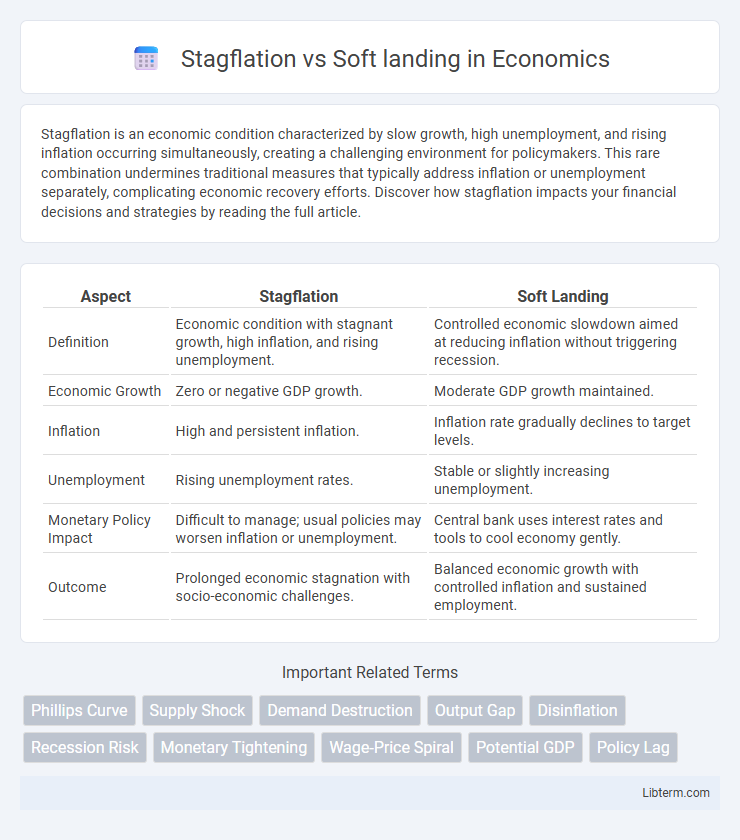Stagflation is an economic condition characterized by slow growth, high unemployment, and rising inflation occurring simultaneously, creating a challenging environment for policymakers. This rare combination undermines traditional measures that typically address inflation or unemployment separately, complicating economic recovery efforts. Discover how stagflation impacts your financial decisions and strategies by reading the full article.
Table of Comparison
| Aspect | Stagflation | Soft Landing |
|---|---|---|
| Definition | Economic condition with stagnant growth, high inflation, and rising unemployment. | Controlled economic slowdown aimed at reducing inflation without triggering recession. |
| Economic Growth | Zero or negative GDP growth. | Moderate GDP growth maintained. |
| Inflation | High and persistent inflation. | Inflation rate gradually declines to target levels. |
| Unemployment | Rising unemployment rates. | Stable or slightly increasing unemployment. |
| Monetary Policy Impact | Difficult to manage; usual policies may worsen inflation or unemployment. | Central bank uses interest rates and tools to cool economy gently. |
| Outcome | Prolonged economic stagnation with socio-economic challenges. | Balanced economic growth with controlled inflation and sustained employment. |
Understanding Stagflation: Definition and Key Features
Stagflation is an economic condition characterized by stagnant growth, high unemployment, and rising inflation simultaneously, creating a challenging environment for policymakers. Unlike a soft landing, which aims to slow economic growth gradually to prevent overheating and control inflation without triggering a recession, stagflation presents a paradox where inflation persists despite weak demand. Key features of stagflation include supply shocks, such as rising oil prices, and structural inefficiencies that disrupt normal economic cycles, making recovery complex and prolonged.
What is a Soft Landing in Economics?
A soft landing in economics refers to a scenario where an economy slows down just enough to curb inflation without triggering a recession, maintaining stable growth and employment levels. This outcome contrasts with stagflation, which combines stagnant growth, high inflation, and rising unemployment. Policymakers aim for a soft landing by adjusting interest rates and fiscal measures to balance economic cooling while avoiding the negative impacts of a sharp downturn.
Historical Examples of Stagflation
The most notable historical example of stagflation occurred in the 1970s when the U.S. economy faced high inflation, stagnant growth, and rising unemployment triggered by oil price shocks and restrictive monetary policies. Japan experienced a mild stagflation period during the early 1970s after the first oil crisis, combining inflationary pressures with sluggish industrial output. Comparing stagflation to a soft landing highlights the difficulty in achieving controlled economic slowdown without triggering inflation, as soft landings typically involve gradual interest rate adjustments to maintain growth and keep inflation in check.
Soft Landing: Past Success Stories and Failures
Soft landing refers to a scenario where economic growth slows down just enough to curb inflation without triggering a recession, seen in the 1994 Federal Reserve's managed interest rate hikes that maintained steady GDP growth and low unemployment. Past successes, such as the late 1990s US economy, demonstrate effective monetary policy balancing inflation control with sustained job creation, avoiding stagflation's combination of stagnant growth and high inflation. Failures in pursuing a soft landing, notably during the 1970s, resulted in prolonged stagflation due to oil shocks and policy missteps that exacerbated inflation without stabilizing economic growth.
Stagflation vs Soft Landing: Core Differences
Stagflation represents a challenging economic scenario where high inflation coincides with stagnant growth and rising unemployment, creating a complex policy dilemma. In contrast, a soft landing describes a controlled economic slowdown aimed at curbing inflation without triggering a recession or significant job losses. The core differences lie in stagflation's simultaneous pressure of inflation and contraction versus soft landing's balanced approach to stabilizing prices while maintaining economic expansion.
Causes and Triggers: Why Economies Face Stagflation
Stagflation occurs when an economy experiences stagnant growth coupled with high inflation, often triggered by supply shocks like rising oil prices or abrupt increases in production costs. In contrast, a soft landing is achieved when central banks successfully slow down economic growth to control inflation without triggering a recession, typically through measured interest rate hikes and demand management. The primary cause of stagflation lies in the simultaneous supply-side constraints and demand persistence, while a soft landing hinges on effective monetary policy balancing inflation and growth.
Economic Indicators Signaling a Soft Landing
Economic indicators signaling a soft landing include stable inflation rates, steady GDP growth, and a gradual improvement in unemployment figures, suggesting the economy avoids the extreme conditions of stagflation. Moderated consumer price index (CPI) increases and consistent consumer confidence levels further support a balanced economic slowdown without triggering recession. Central banks monitor these metrics closely to adjust monetary policy, aiming to sustain growth while curbing inflationary pressures.
Central Bank Strategies: Tackling Stagflation vs Achieving a Soft Landing
Central banks facing stagflation prioritize tightening monetary policy to curb inflation despite risks of slowing growth, often resulting in higher interest rates and constrained credit. In contrast, strategies for achieving a soft landing emphasize gradual rate hikes and targeted interventions to moderate inflation without triggering a recession. The balance between these approaches depends on inflation expectations, labor market conditions, and external economic shocks influencing policy decisions.
Impact on Businesses and Consumers
Stagflation, characterized by rising inflation and stagnant economic growth, erodes consumer purchasing power and increases operational costs for businesses, leading to reduced profit margins and lower consumer demand. In contrast, a soft landing scenario stabilizes inflation while maintaining economic growth, allowing businesses to manage costs effectively and supporting steady consumer spending. The divergent impacts influence corporate investment decisions, pricing strategies, and overall market confidence.
Future Outlook: Navigating Between Stagflation and Soft Landing
Future economic stability hinges on managing inflation and growth without triggering a recession, as policymakers aim to avoid stagflation characterized by stagnant demand and high inflation. Central banks' ability to adjust interest rates judiciously and maintain employment levels signals potential for a soft landing with moderate growth and controlled inflation. Market forecasts emphasize vigilance in inflation trends and supply chain resilience to navigate between these outcomes effectively.
Stagflation Infographic

 libterm.com
libterm.com